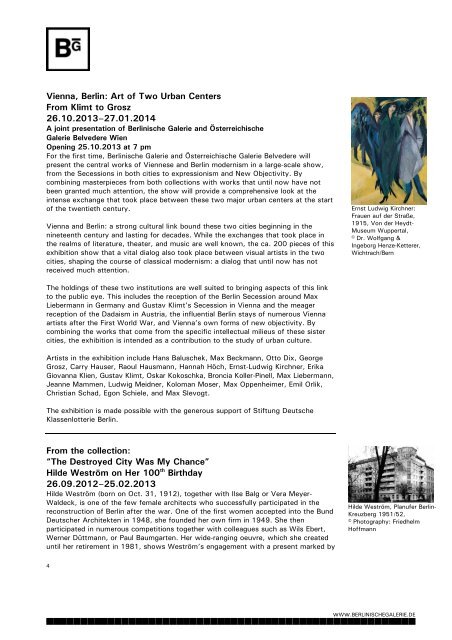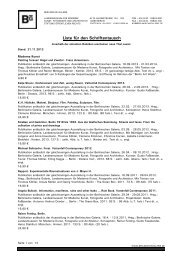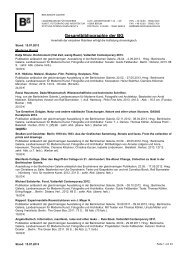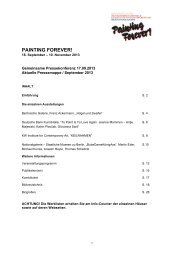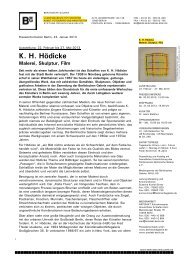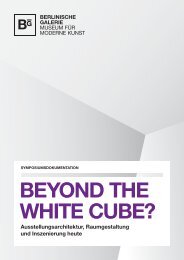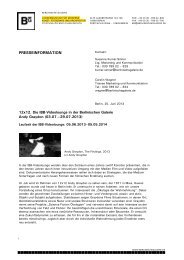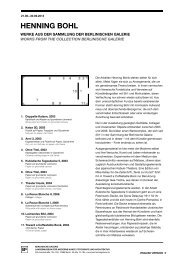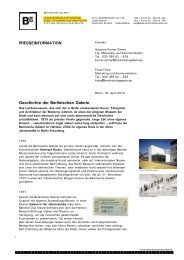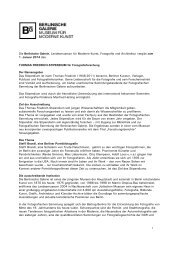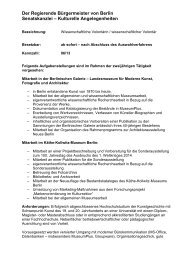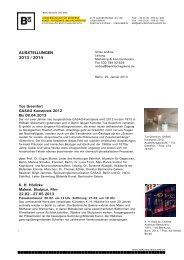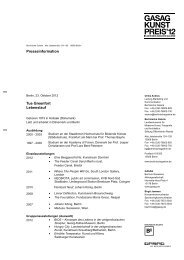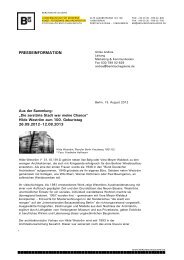EXHIBITIONS 2012 / 2013 - Berlinische Galerie
EXHIBITIONS 2012 / 2013 - Berlinische Galerie
EXHIBITIONS 2012 / 2013 - Berlinische Galerie
Create successful ePaper yourself
Turn your PDF publications into a flip-book with our unique Google optimized e-Paper software.
Vienna, Berlin: Art of Two Urban Centers<br />
From Klimt to Grosz<br />
26.10.<strong>2013</strong>–27.01.2014<br />
A joint presentation of <strong>Berlinische</strong> <strong>Galerie</strong> and Österreichische<br />
<strong>Galerie</strong> Belvedere Wien<br />
Opening 25.10.<strong>2013</strong> at 7 pm<br />
For the first time, <strong>Berlinische</strong> <strong>Galerie</strong> and Österreichische <strong>Galerie</strong> Belvedere will<br />
present the central works of Viennese and Berlin modernism in a large-scale show,<br />
from the Secessions in both cities to expressionism and New Objectivity. By<br />
combining masterpieces from both collections with works that until now have not<br />
been granted much attention, the show will provide a comprehensive look at the<br />
intense exchange that took place between these two major urban centers at the start<br />
of the twentieth century.<br />
Vienna and Berlin: a strong cultural link bound these two cities beginning in the<br />
nineteenth century and lasting for decades. While the exchanges that took place in<br />
the realms of literature, theater, and music are well known, the ca. 200 pieces of this<br />
exhibition show that a vital dialog also took place between visual artists in the two<br />
cities, shaping the course of classical modernism: a dialog that until now has not<br />
received much attention.<br />
The holdings of these two institutions are well suited to bringing aspects of this link<br />
to the public eye. This includes the reception of the Berlin Secession around Max<br />
Liebermann in Germany and Gustav Klimt’s Secession in Vienna and the meager<br />
reception of the Dadaism in Austria, the influential Berlin stays of numerous Vienna<br />
artists after the First World War, and Vienna’s own forms of new objectivity. By<br />
combining the works that come from the specific intellectual milieus of these sister<br />
cities, the exhibition is intended as a contribution to the study of urban culture.<br />
Artists in the exhibition include Hans Baluschek, Max Beckmann, Otto Dix, George<br />
Grosz, Carry Hauser, Raoul Hausmann, Hannah Höch, Ernst-Ludwig Kirchner, Erika<br />
Giovanna Klien, Gustav Klimt, Oskar Kokoschka, Broncia Koller-Pinell, Max Liebermann,<br />
Jeanne Mammen, Ludwig Meidner, Koloman Moser, Max Oppenheimer, Emil Orlik,<br />
Christian Schad, Egon Schiele, and Max Slevogt.<br />
The exhibition is made possible with the generous support of Stiftung Deutsche<br />
Klassenlotterie Berlin.<br />
From the collection:<br />
“The Destroyed City Was My Chance”<br />
Hilde Weström on Her 100 th Birthday<br />
26.09.<strong>2012</strong>–25.02.<strong>2013</strong><br />
Hilde Weström (born on Oct. 31, 1912), together with Ilse Balg or Vera Meyer-<br />
Waldeck, is one of the few female architects who successfully participated in the<br />
reconstruction of Berlin after the war. One of the first women accepted into the Bund<br />
Deutscher Architekten in 1948, she founded her own firm in 1949. She then<br />
participated in numerous competitions together with colleagues such as Wils Ebert,<br />
Werner Düttmann, or Paul Baumgarten. Her wide-ranging oeuvre, which she created<br />
until her retirement in 1981, shows Weström’s engagement with a present marked by<br />
4<br />
Ernst Ludwig Kirchner:<br />
Frauen auf der Straße,<br />
1915, Von der Heydt-<br />
Museum Wuppertal,<br />
© Dr. Wolfgang &<br />
Ingeborg Henze-Ketterer,<br />
Wichtrach/Bern<br />
Hilde Weström, Planufer Berlin-<br />
Kreuzberg 1951/52,<br />
© Photography: Friedhelm<br />
Hoffmann<br />
wWw.BERLINISCHEGALERIE.DE<br />
������������������������������������������������������


